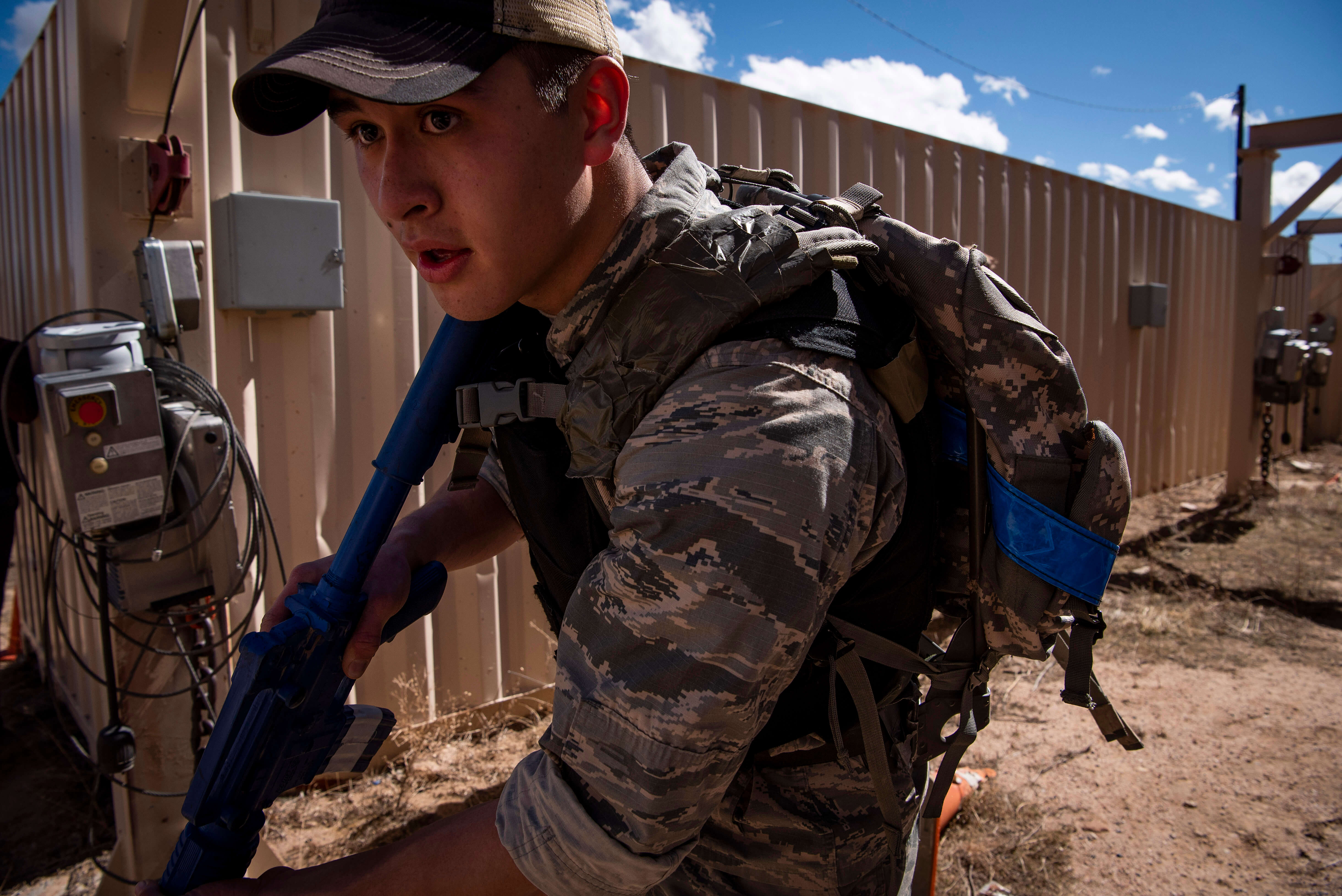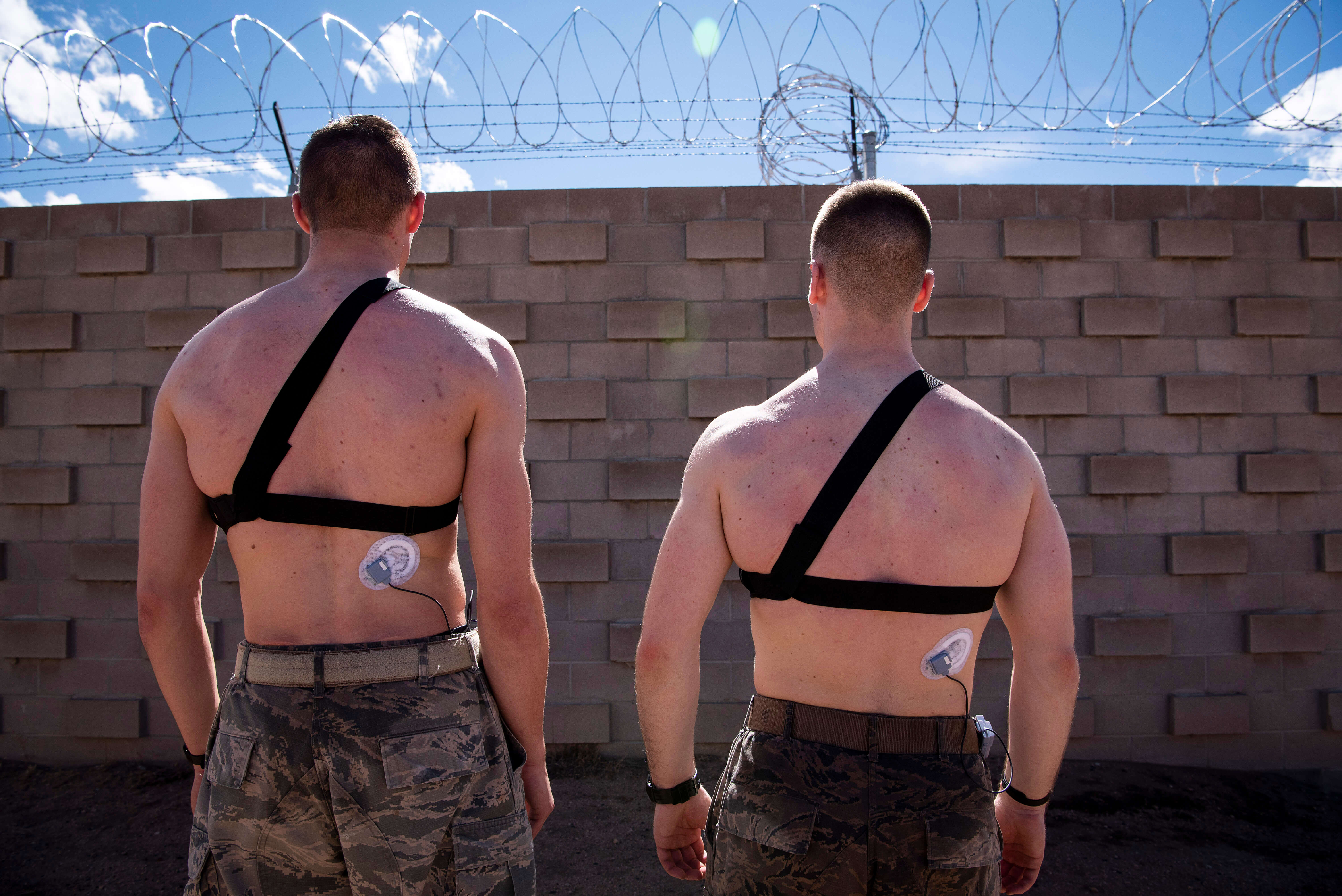Air Force Academy cadets test sensors designed to improve warfighter abilities

(U.S. Air Force photo/Joshua Armstrong)
Story by Ray Bowden, March 21, 2019
U.S. AIR FORCE ACADEMY, Colo. — General Norman Schwarzkopf once said, “The more you sweat in peace, the less you bleed in war.”
Cadets at the Air Force Academy took the former Gulf War leader at his word when they helped the Air Force and one of the Academy’s research partners, a public firm specializing in biology and applied physics, test a prototype of a human-behavior sensor designed to check their perspiration, March 12.
The sensors, designed by GE Global Research, one of many Defense Department research partners, were attached to the cadets’ backs on a belt above their waist.
“That part of the back is one of the sweatiest areas. It’s like a pool back there,” said” Lt. Col. Chad Tossell, director of the Academy’s warfighting effectiveness research center in the school’s behavioral sciences department. Tossell watched the eight cadets sweep through the Military Operations-Urban Training village in Jacks Valley while carrying 45-pound backpacks and training rifles.
The day-long testing activities also took the cadets, all members of the Academy’s combat shooting team, through a series of warm-up exercises, two 1.5 mile ruck marches, and various briefings.
“These sensors are designed to passively and noninvasively assess properties and function of human sweat in real-time,” Dr. Adam Strang, director of the signature tracking for optimized nutrition and training laboratory at the Air Force Research Laboratory at Wright Patterson Air Force Base, Ohio. “We use this information to index the physiological process, such as hydration and stress levels, known to critically impact human performance.”
The data from the test will develop what Strang calls personalized augmentation strategies, “such as a sports drink with an electrolyte and sugar composition, designed specifically for ‘you’ to maintain, optimize and enhance Airman performance in training and mission settings.”
“This is about cadets and capability,” he said.
When cadets perspire, the sensor records potassium and sodium levels in their perspiration and sends the data to a cellphone app or computer, said Cadet 1st Class Dave Culver, one of four systems engineering students who organized the logistics for the day’s activities.
“Each cadet testing a sensor today has the app with them,” he said.
Tossell said the Academy is known across the DoD and in the research and development realm as an optimal setting site to try-out burgeoning technology.
“It’s attractive because we have a controlled environment and we’re doing real-world testing,” he said. “The tests are sponsored by the AFRL at Wright-Patterson.”
Cadet 3rd Class Isaac Perkins participated in the March 12 test.
“Testing new technology is an excellent opportunity for cadets to get involved and exposed to real technologies the Air Force is using,” he said. “If there’s one way to get cadets excited, it’s giving them exposure to the special operations community.”
The sensor patch’s first generation was lab-tested with simulated sweat by GE Global Research. Additional physiological performance testing occurred at the signature tracking for optimized nutrition and training laboratory under Strang, according to a 2018 news report from Wright Patterson.
“These tests allow me to develop and validate next-generation sensor technology with a representative population — cadets training to enter special operations career fields,” Strang said.
Strang said the Academy is a boon to the AFRL and the DoD due to its opportune testing environment.
“I can evaluate the state of these sensors, identify tech gaps and decide how the AFRL needs to meet those gaps, either through internal research and development or funding commercial performers to reach our goal: a robust set of sensors to assess performance states,” he said.
Perkins appreciates the influence research at the Academy has for the DoD on a global scale.
“It was super encouraging to see the amount of research and focus that’s going into human performance technology here,” he said. “It would be great to know that our participation contributed to technology my teammates and I may have to use one day.”
Due to weather conditions March 14, testing of a similar product designed by Northwestern University researchers was cancelled.
“It has been rescheduled for Tech Warrior at the AFRL,” Tossell said. “We’ll bring in next year’s capstone cadets.”
Tech Warrior is an annual AFRL exercise taking place in the fall. The event is designed to provide scientists and engineers the opportunity to participate in an intense battlefield immersion training exercise with Airmen they create new technologies for.

Two cadets wear a prototype of a human-behavior sensor designed to check their perspiration, March 12, 2019 in Jacks Valley. The device is the result of an ongoing collaboration between the signature tracking for optimized nutrition and training laboratory at the Air Force Research Laboratory at Wright Patterson Air Force Base, Ohio, and GE Global Research. (U.S. Air Force photo/Joshua Armstrong)